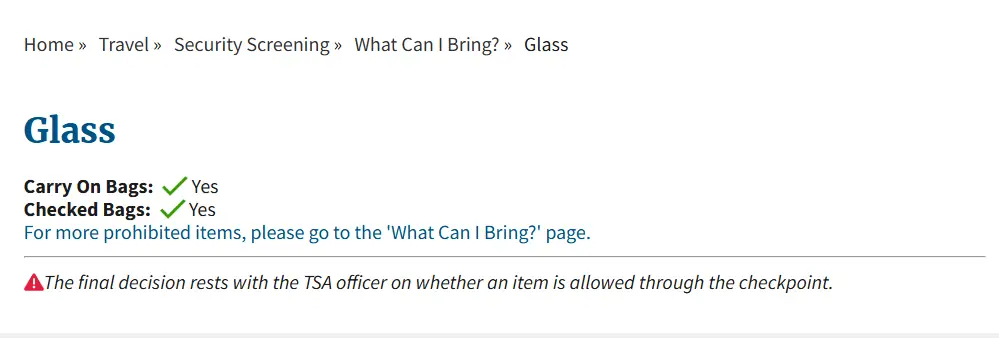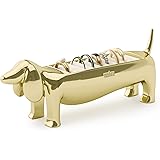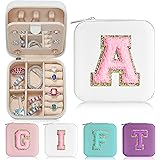Planning to travel with glass items? Whether it’s a delicate souvenir, a cherished glassware collection, or essential medication in a glass container, navigating airport security with glass can feel like walking on eggshells. The rules can be complex, and understanding what’s allowed – and where – is crucial to avoid unexpected delays or, worse, having your precious items confiscated.
This comprehensive guide provides the most up-to-date information on bringing glass on a plane in 2025, including TSA regulations, packing tips, and answers to frequently asked questions. We’ll help you travel with confidence, knowing you’ve done everything possible to protect your glass items and ensure a smooth journey.
Table of Contents
Introduction: The Fragile Frontier of Air Travel
Air travel is already stressful enough without adding the worry of transporting fragile items. Glass, in particular, presents a unique challenge. Not only is it susceptible to breakage, but it also falls under varying TSA regulations depending on its nature and purpose. A decorative glass bottle, for example, might be treated differently than a vial of prescription medication. Staying informed about these distinctions is paramount.
In this guide, we’ll break down the TSA’s guidelines on glass items, explore packing strategies that minimize the risk of damage, and address common concerns about traveling with specific types of glass. Whether you’re a seasoned traveler or a first-time flyer, this resource will equip you with the knowledge and practical advice you need to navigate airport security with glass safely and efficiently.
Understanding TSA Regulations on Glass Items
The Transportation Security Administration (TSA) has specific rules about what you can bring on a plane, and these rules apply to glass items as well. The key factor is whether the item is considered a potential weapon or a safety hazard. The guidelines also differ based on whether you’re packing the glass item in your carry-on or checked baggage.
General Rules for Carry-On vs. Checked Baggage
Generally speaking, the TSA is more restrictive about items in carry-on baggage. This is because items in the cabin are more readily accessible and could potentially be used in a harmful way. Checked baggage, on the other hand, goes into the cargo hold and is subject to less stringent regulations, although it still needs to be safe for transport.

- Carry-on Baggage: Limited to smaller quantities and must adhere to the 3-1-1 liquids rule (more on that later). Items deemed potentially dangerous are often prohibited.
- Checked Baggage: More flexibility in terms of quantity and size, but still subject to restrictions on hazardous materials. Proper packing is essential to prevent damage.
Specific Glass Items and Their TSA Status
Let’s delve into the specific rules for some common glass items:
Glass Bottles and Containers
Glass bottles and containers are generally allowed in both carry-on and checked baggage, but with some caveats.
- Carry-on: If the container holds liquids, gels, aerosols, creams, or pastes, it must comply with the 3-1-1 rule: containers must be 3.4 ounces (100 milliliters) or less and fit into a quart-sized, clear plastic zip-top bag. Only one bag is allowed per passenger. This rule applies to items like travel-sized toiletries, liquid medications, and even certain food items like jams or honey.
- Checked Baggage: Larger bottles and containers are allowed in checked baggage, but they must be properly packed to prevent breakage and leakage. Consider wrapping each item individually in bubble wrap or clothing, and placing them in a sealed plastic bag to contain any spills.
Real-World Example: Imagine you’re bringing back a bottle of olive oil from a trip to Italy. If you want to carry it on, it needs to be in a container that’s 3.4 ounces or less and stored in your quart-sized bag. Otherwise, pack it securely in your checked baggage.
Glassware (e.g., Vases, Dishes, Ornaments)
Glassware such as vases, dishes, and ornaments are generally permitted in both carry-on and checked baggage, but the TSA emphasizes the importance of packing them securely to prevent breakage.
- Carry-on: While technically allowed, carrying glassware in your carry-on is generally not recommended due to the risk of breakage and the limited space available. If you must bring it, ensure it’s well-protected and doesn’t exceed the size or weight limitations for carry-on baggage.
- Checked Baggage: This is the more practical option for transporting glassware. Wrap each item individually in multiple layers of bubble wrap, packing peanuts, or clothing. Place the wrapped items in a sturdy box, filling any empty spaces with more packing material to prevent movement during transit. Mark the box as “Fragile” to alert baggage handlers.
Real-World Example: You’ve purchased a beautiful hand-blown glass ornament as a souvenir. It’s best to pack it in your checked baggage, carefully wrapped and cushioned, to avoid any mishaps during the flight.
Glass Picture Frames
Similar to glassware, glass picture frames are permitted but require careful handling.
- Carry-on: Small picture frames may be allowed, but larger ones are best packed in checked baggage. Consider removing the glass pane and packing it separately to reduce the risk of breakage.
- Checked Baggage: Wrap the frame and glass pane separately in bubble wrap or other protective material. Place them in a sturdy box with adequate cushioning.
Eyeglasses and Prescription Glasses
Eyeglasses and prescription glasses are generally allowed in both carry-on and checked baggage without any special restrictions. However, it’s highly recommended to carry them in your carry-on to avoid the risk of damage or loss.
- Carry-on: The best place for your glasses is in your carry-on, preferably in a hard case to protect them from damage.
- Checked Baggage: While you can technically pack them in your checked baggage, it’s not advisable due to the potential for damage.
Glass Medication Bottles
Glass medication bottles are allowed in both carry-on and checked baggage, but there are specific guidelines to follow, especially for liquid medications.
- Carry-on: Liquid medications are exempt from the 3-1-1 rule if they are deemed medically necessary. However, it’s always a good idea to inform the TSA officer about your medication and have a prescription or doctor’s note handy. The medication should be clearly labeled.
- Checked Baggage: Medications can be packed in checked baggage, but it’s generally recommended to keep essential medications in your carry-on in case of lost or delayed baggage.
TSA Tip: According to the TSA website, “Medication in liquid form is allowed in carry-on bags in excess of 3.4 ounces or 100 milliliters. You are not required to place these items in a quart-sized bag. However, you must declare them to the TSA officer at the checkpoint for inspection.” It’s always a good idea to check the latest regulations on the TSA website.
Thermometers (Glass with Mercury)
Thermometers containing mercury are subject to specific regulations due to the potential hazards of mercury exposure. Check the airline’s policy as well, as some may have stricter guidelines.
- Carry-on: Generally prohibited.
- Checked Baggage: May be allowed, but with strict limitations. The thermometer must be packaged in a sealed container to prevent leakage. Some airlines may prohibit them altogether. Contact your airline before traveling with a mercury thermometer.
Glass Test Tubes and Scientific Equipment
Glass test tubes and other scientific equipment are generally allowed, but may require additional screening. If they contain liquids, the 3-1-1 rule or the medication exception may apply.
- Carry-on: Allowed, but subject to screening. If containing liquids, must comply with 3-1-1 rule or medication exception if applicable.
- Checked Baggage: Allowed, but should be packed securely to prevent breakage.
TSA Recommendation: The TSA recommends contacting them directly or using the “Ask TSA” feature on their website or mobile app if you have any specific questions about a particular glass item. This can help avoid confusion and ensure a smooth security screening process.
Table: TSA Guidelines for Glass Items in 2025
| Item | Carry-On Baggage | Checked Baggage | Notes |
|---|---|---|---|
| Glass Bottles (containing liquids) | Allowed if 3.4 oz (100ml) or less and in a quart-sized bag | Allowed | Larger bottles must be in checked baggage. |
| Glassware (vases, dishes, ornaments) | Allowed, but not recommended due to risk of breakage | Allowed | Must be packed securely. |
| Glass Picture Frames | Small frames allowed; larger frames best in checked baggage | Allowed | Consider removing glass pane and packing separately. |
| Eyeglasses/Prescription Glasses | Allowed; recommended to carry in a hard case | Allowed | Not recommended to check due to risk of damage. |
| Glass Medication Bottles (liquids) | Allowed, even if over 3.4 oz, if medically necessary; declare to TSA officer | Allowed | Recommended to carry essential medications in carry-on. |
| Thermometers (Glass with Mercury) | Generally Prohibited | May be allowed with restrictions; check with airline | Must be in a sealed container; some airlines may prohibit. |
| Glass Test Tubes & Scientific Equipment | Allowed, subject to screening; liquids must comply with 3-1-1 or medication exception | Allowed | Pack securely to prevent breakage. |
Packing Tips to Protect Glass Items
Even if the TSA allows you to bring a particular glass item, proper packing is crucial to prevent breakage during transit. Here are some essential packing tips:
Essential Packing Materials
Having the right packing materials is the first step in ensuring the safety of your glass items.
- Bubble Wrap: This is your best friend when packing fragile items. Use multiple layers to provide ample cushioning.
- Packing Peanuts: These lightweight foam pieces fill empty spaces in boxes, preventing items from shifting during transit.
- Packing Paper: Use packing paper to wrap individual items and fill smaller gaps. Newspaper can also be used, but be aware that the ink can transfer to your items.
- Sturdy Boxes: Use strong, corrugated cardboard boxes that are appropriately sized for your items. Avoid using flimsy boxes that could easily collapse.
- Packing Tape: Use strong packing tape to seal boxes securely.
- “Fragile” Stickers: Clearly label your boxes as “Fragile” to alert baggage handlers to handle them with care.
- Plastic Bags: Sealable plastic bags can help contain leaks from liquid-filled glass containers.
Step-by-Step Packing Guide
Follow these steps for packing glass items safely:
- Wrap Each Item Individually: Wrap each glass item in multiple layers of bubble wrap or packing paper. Secure the wrapping with tape.
- Cushion the Bottom of the Box: Place a layer of packing peanuts or crumpled packing paper at the bottom of the box to provide cushioning.
- Place Items in the Box: Arrange the wrapped items in the box, ensuring that they are not touching each other. Place heavier items at the bottom and lighter items on top.
- Fill Empty Spaces: Fill any empty spaces in the box with packing peanuts or crumpled packing paper to prevent the items from shifting.
- Cushion the Top of the Box: Place another layer of packing peanuts or crumpled packing paper on top of the items to provide cushioning.
- Seal the Box Securely: Seal the box with strong packing tape, covering all seams and edges.
- Label the Box as “Fragile”: Affix “Fragile” stickers to all sides of the box.
Specific Packing Techniques for Different Glass Items
Here are some additional tips for packing specific types of glass items:
Glass Bottles and Jars
- Wrap each bottle or jar individually in bubble wrap.
- Place a layer of cardboard between bottles to prevent them from clinking together.
- If the bottles contain liquids, ensure the caps are tightly sealed and consider using a sealant like plumber’s tape to prevent leaks. Place each bottle in a sealed plastic bag.
- Pack the bottles in a sturdy box with plenty of cushioning.
Glassware (Vases, Dishes, Ornaments)
- Wrap each item individually in multiple layers of bubble wrap.
- Pay special attention to delicate parts like handles or stems, providing extra cushioning.
- Place the wrapped items in a sturdy box with plenty of packing peanuts or crumpled packing paper.
Glass Picture Frames
- Remove the glass pane from the frame, if possible.
- Wrap the frame and glass pane separately in bubble wrap.
- Place them in a sturdy box with adequate cushioning.
Using Suitcases for Glass Transport
While boxes are generally better for protecting fragile items, you can also use suitcases to transport glass, provided you take extra precautions.
- Choose a Suitcase with Hard Sides: A hard-sided suitcase will provide more protection than a soft-sided one.
- Wrap Items Thoroughly: Wrap each item individually in multiple layers of bubble wrap or clothing.
- Place Items in the Center of the Suitcase: Place the wrapped items in the center of the suitcase, surrounded by soft items like clothing.
- Fill Empty Spaces: Fill any empty spaces with clothing or other soft items to prevent the items from shifting.
Real-World Example: A traveler successfully transported a set of delicate teacups by wrapping each cup and saucer individually in clothing and placing them in the center of their hard-sided suitcase, surrounded by more clothing. The suitcase was clearly marked as “Fragile,” and the teacups arrived intact.
Insurance Considerations
Consider purchasing travel insurance that covers damage or loss of your belongings. This can provide peace of mind and financial protection in case of unforeseen circumstances.
Tip: Take photos of your packed items before you travel. This can be helpful in case you need to file an insurance claim.
Navigating Airport Security with Glass
Even with careful packing, navigating airport security with glass items can be stressful. Here’s what to expect and how to prepare:
What to Expect at the Security Checkpoint
Be prepared to remove your glass items from your bag for inspection by TSA officers. This is especially likely if the items are large or unusually shaped.
- Declare Your Items: Inform the TSA officer that you are carrying glass items.
- Follow Instructions: Follow the TSA officer’s instructions carefully. They may ask you to open your bag or remove specific items for closer inspection.
- Be Patient: Security screenings can take time, especially during peak travel periods. Be patient and cooperative with the TSA officers.
Tips for a Smooth Security Screening
Here are some tips to help you get through security quickly and efficiently:
- Pack Smart: Pack your glass items in a way that makes them easy to remove for inspection. Place them in a separate compartment or bag within your carry-on.
- Arrive Early: Give yourself plenty of time to get through security. This will reduce your stress level and allow you to handle any unexpected delays.
- Dress Appropriately: Avoid wearing clothing or accessories that could trigger the metal detector.
- Be Prepared to Remove Electronics: You will need to remove laptops and other large electronics from your bag for screening.
- Cooperate with TSA Officers: Be polite and cooperative with the TSA officers. They are there to ensure your safety and the safety of other passengers.
Dealing with Potential Issues
If a TSA officer has concerns about your glass item, be prepared to explain its purpose and how it is packed. If the officer decides that the item is not allowed, you may have the option to:
- Place the Item in Your Checked Baggage: If you have checked baggage, you may be able to place the item in your checked bag.
- Ship the Item: You may be able to ship the item to your destination or back home.
- Surrender the Item: If you cannot place the item in your checked baggage or ship it, you may have to surrender it to the TSA.
TSA PreCheck and Global Entry
If you are a member of TSA PreCheck or Global Entry, you may be able to go through a faster security screening process. However, you will still need to comply with the TSA’s rules regarding glass items.
Note: TSA PreCheck and Global Entry do not guarantee that you will be exempt from secondary screening. TSA officers may still conduct additional screenings if they have concerns about your belongings.
Specific Scenarios: Traveling with Different Types of Glass
Let’s consider some specific scenarios and how the rules might apply:
Traveling with Wine or Liquor
Bringing wine or liquor on a plane requires careful consideration of both TSA and airline regulations.
- Carry-on: Wine and liquor are subject to the 3-1-1 rule if they are in containers of 3.4 ounces (100 milliliters) or less. Larger bottles are prohibited in carry-on baggage.
- Checked Baggage: Wine and liquor can be transported in checked baggage, but they must be properly packed to prevent breakage. Many airlines have specific regulations regarding the alcohol content of beverages transported in checked baggage. Check with your airline before traveling.
TSA Regulation: According to the TSA, “You may transport unopened alcohol beverages in carry-on or checked baggage as long as it complies with the 3-1-1 liquids rule for carry-on baggage, or it is transported in checked baggage. The alcoholic content must not exceed 70% (140 proof).”
Real-World Example: A traveler wanted to bring back a bottle of expensive scotch from Scotland. They packed it carefully in a wine suitcase specifically designed for transporting bottles, ensuring it was well-cushioned and protected. They also checked the airline’s regulations regarding alcohol content and declared the bottle at customs upon arrival.
Traveling with Perfume or Cologne
Perfume and cologne are generally allowed on planes, but they are subject to the 3-1-1 rule if carried on.
- Carry-on: Perfume and cologne bottles must be 3.4 ounces (100 milliliters) or less and fit into a quart-sized, clear plastic zip-top bag.
- Checked Baggage: Larger bottles of perfume and cologne are allowed in checked baggage, but they should be packed securely to prevent leakage and breakage.
Traveling with Baby Food in Glass Jars
Baby food is exempt from the 3-1-1 rule, but you may need to undergo additional screening.
- Carry-on: Baby food is allowed in carry-on baggage in reasonable quantities. You should inform the TSA officer that you are carrying baby food. They may ask you to open the jars for inspection.
- Checked Baggage: Baby food can also be packed in checked baggage.
TSA Tip: According to the TSA, “Formula, breast milk, juice in quantities greater than 3.4 ounces or 100 milliliters are allowed in carry-on baggage and do not need to fit within a quart-sized bag. Remove these items from your carry-on bag to be screened separately from the rest of your belongings.”
Traveling with Antique Glassware
Antique glassware requires extra care and attention when traveling.
- Carry-on: While technically allowed, carrying antique glassware in your carry-on is generally not recommended due to the risk of breakage and the limited space available.
- Checked Baggage: Pack each item individually in multiple layers of bubble wrap, packing peanuts, or clothing. Place the wrapped items in a sturdy box, filling any empty spaces with more packing material to prevent movement during transit. Consider insuring the items for their full value.
Traveling with Scientific Samples in Glass Vials
Scientific samples in glass vials may be subject to specific regulations, depending on the nature of the samples.
- Carry-on: Allowed, but subject to screening. If containing liquids, must comply with 3-1-1 rule or medication exception if applicable.
- Checked Baggage: Allowed, but should be packed securely to prevent breakage. If the samples are hazardous, you must comply with all applicable regulations for transporting hazardous materials. Contact your airline and the relevant authorities for guidance.
Current Trends and Statistics in Air Travel with Glass
Understanding current trends and statistics can help you navigate air travel with glass more effectively.
Increasing Demand for Travel with Fragile Items
With the rise of e-commerce and global tourism, more people are traveling with fragile items like glass than ever before. This has led to increased awareness of the challenges involved and a growing demand for better packing and shipping solutions.
Common Causes of Damage to Glass Items During Air Travel
The most common causes of damage to glass items during air travel include:

carry-on glassware
- Improper Packing: Inadequate cushioning and protection can lead to breakage during handling.
- Rough Handling by Baggage Handlers: Baggage handlers may not always handle fragile items with the care they require.
- Temperature and Pressure Changes: Extreme temperature and pressure changes in the cargo hold can cause glass to crack or shatter.
- Shifting During Transit: Items that are not properly secured within the box or suitcase can shift during transit, leading to breakage.
Statistics on Lost and Damaged Baggage
According to recent reports, the rate of lost and damaged baggage has been increasing in recent years. While the exact figures vary depending on the airline and the route, it’s clear that there is a significant risk of baggage being lost or damaged during air travel. This underscores the importance of taking extra precautions when traveling with fragile items like glass.
Statistic: A study by SITA, an air transport IT provider, found that mishandled baggage rates increased in 2022 compared to previous years. While the numbers fluctuate annually, it highlights the ongoing risk of baggage issues. (*_**Find and insert a specific statistic with citation here**_*)
Trends in Packing Technology and Materials
There are several emerging trends in packing technology and materials that can help protect glass items during air travel:
- Air Pillows: These inflatable cushions provide excellent protection and can be customized to fit the shape of your items.
- Biodegradable Packing Peanuts: These environmentally friendly packing peanuts are made from cornstarch and dissolve in water.
- Smart Packaging: Some companies are developing smart packaging solutions that use sensors to monitor temperature, humidity, and impact during transit.
The Future of Traveling with Glass
As technology advances and travel patterns evolve, the future of traveling with glass is likely to see some significant changes.
Potential Changes in TSA Regulations
The TSA is constantly updating its regulations to address emerging threats and improve security. It’s possible that the rules regarding glass items may change in the future. For example, the TSA may implement new screening technologies that can detect hazardous liquids or materials more effectively, potentially leading to changes in the 3-1-1 rule.
Advancements in Packing Materials and Techniques
We can expect to see continued advancements in packing materials and techniques, with a focus on developing more sustainable and effective solutions. This could include the use of new materials that are stronger, lighter, and more environmentally friendly, as well as innovative packing techniques that provide better protection against damage.

glass container travel
Increased Use of Technology to Track and Monitor Fragile Items
The use of technology to track and monitor fragile items during air travel is likely to increase in the future. This could include the use of sensors that can monitor temperature, humidity, and impact, as well as tracking devices that can provide real-time information on the location of your belongings. This would allow you to monitor the condition of your glass items during transit and take action if necessary to prevent damage.
FAQ: Frequently Asked Questions About Bringing Glass on a Plane
Here are some frequently asked questions about bringing glass on a plane:
Can I bring a glass water bottle on a plane?
Yes, you can bring a glass water bottle on a plane. If it’s empty, you can bring it in your carry-on or checked baggage. If it contains liquid, it must comply with the 3-1-1 rule (3.4 ounces or less and in a quart-sized bag) if you’re carrying it on. Otherwise, it can be in your checked baggage.
Is it safe to pack glass in checked baggage?
Yes, it is safe to pack glass in checked baggage if you pack it properly. Wrap each item individually in multiple layers of bubble wrap or packing paper, and place them in a sturdy box with plenty of cushioning. Mark the box as “Fragile.”
Can I bring a glass souvenir from my trip in my carry-on?
Technically, yes, but it’s generally not recommended due to the risk of breakage and the limited space. It’s better to pack it securely in your checked baggage.
Are glass baby food jars allowed on planes?
Yes, baby food is allowed in carry-on baggage in reasonable quantities. You should inform the TSA officer that you are carrying baby food. They may ask you to open the jars for inspection. It can also be packed in checked baggage.
What if my liquid medication is in a glass bottle larger than 3.4 ounces?
Liquid medications are exempt from the 3-1-1 rule if they are deemed medically necessary. Inform the TSA officer about your medication and have a prescription or doctor’s note handy. The medication should be clearly labeled.
Can I bring wine or liquor in my checked baggage?
Yes, wine and liquor can be transported in checked baggage, but they must be properly packed to prevent breakage. Many airlines have specific regulations regarding the alcohol content of beverages transported in checked baggage. Check with your airline before traveling.
What happens if the TSA finds a prohibited glass item in my carry-on?
If the TSA finds a prohibited glass item in your carry-on, you may have the option to place the item in your checked baggage, ship the item, or surrender the item to the TSA.
Are there any special rules for transporting antique glassware?
Antique glassware requires extra care and attention when traveling. Pack each item individually in multiple layers of bubble wrap, packing peanuts, or clothing. Place the wrapped items in a sturdy box, filling any empty spaces with more packing material to prevent movement during transit. Consider insuring the items for their full value.
How can I find out the most up-to-date TSA regulations on glass items?
The best way to find out the most up-to-date TSA regulations is to visit the TSA website or use the “Ask TSA” feature on their website or mobile app.
Does TSA PreCheck or Global Entry make it easier to travel with glass items?
TSA PreCheck and Global Entry can speed up the security screening process, but you will still need to comply with the TSA’s rules regarding glass items. These programs do not guarantee that you will be exempt from secondary screening.
Navigating Air Travel with Glass
Traveling with glass on a plane can seem daunting, but with the right knowledge and preparation, it’s entirely manageable. By understanding the TSA’s regulations, following effective packing techniques, and being prepared for security screening, you can minimize the risk of damage and ensure a smooth journey. Remember to always prioritize safety and compliance with the rules, and when in doubt, consult the TSA directly for clarification. The inconvenience of asking is far less than the hassle and heartbreak of having a treasured item confiscated or broken.
In 2025, the key takeaways remain the same: pack smart, declare your items, and be patient. The evolving trends in travel, from increased tourism to the growing demand for transporting specialty goods, are only amplifying the need for travelers to be informed and proactive. While the TSA works to adapt its procedures to balance security with convenience, travelers must do their part by staying updated on the latest guidelines and taking responsibility for the safe transport of their belongings.
Conclusion: Final Thoughts on Flying with Glass
Traveling with glass items on a plane requires careful planning and preparation. By understanding the TSA’s regulations, packing your items securely, and being prepared to navigate security checkpoints, you can minimize the risk of damage and ensure a smooth travel experience. Remember to prioritize safety and be respectful of TSA officers. If you’re unsure about whether a particular glass item is allowed, err on the side of caution and consider shipping it to your destination instead. With a little bit of foresight, you can successfully transport your glass belongings and enjoy your trip without any unnecessary stress.
As air travel evolves and security measures adapt, staying informed is crucial. Make use of the TSA’s resources, including their website and app, to remain updated on the latest regulations. Don’t underestimate the value of proper packing; invest in quality bubble wrap, padding, and consider hard-sided luggage for added protection. If you’re carrying valuable or sentimental glass items, shipping them might be the most sensible choice, offering peace of mind and reducing the chances of damage during transit.
Ultimately, the decision of whether to bring glass on a plane depends on your individual circumstances, the nature of the glass item, and your risk tolerance. Weigh the pros and cons carefully, consider alternative options, and always prioritize safety and compliance with regulations. A well-prepared traveler is a confident traveler, and knowing the ins and outs of flying with glass can make your journey all the more enjoyable. And remember, while this guide is comprehensive, TSA agents have the final say, so be respectful and understanding of their decisions. Have a safe and pleasant trip!






